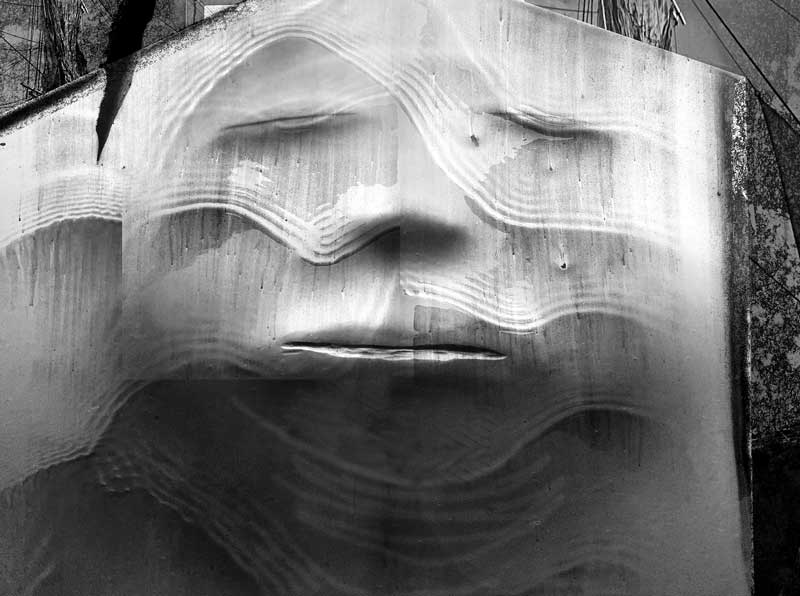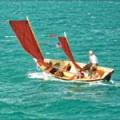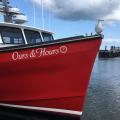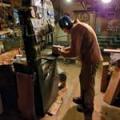Jeffery Becton’s Invented Worlds
This Deer Isle photographer uses digital means to explore “the edges of realism”
Images courtesy the artist
 Jeffery Becton’s 2017 digital montage Off Spirit Ledge combines images from South America and Nova Scotia.
Jeffery Becton’s 2017 digital montage Off Spirit Ledge combines images from South America and Nova Scotia.
On a gorgeous late-August morning, artist Jeffery Becton came off his boat Sculpin, a 53-foot Selene trawler, to meet this writer at his house in Deer Isle overlooking Southeast Harbor. As we talked, he shared stories of the sea—and art.
An avid seafarer from early in his life, Becton continues to find the experience fascinating and potent. Describing a recent foggy day on the water, he recounted how one minute he couldn’t see his hand in front of his face, the next he could see “two islands” away, and then just as quickly, the fog closed back in. “It teaches you something about how you can be wrong about what you’re imagining is out there in the fog,” Becton said. “Your imagination cannot stop; it just has to keep imagining what’s really there.”
Becton might be describing his photographs—compelling digital composites that conjure what the world might look like when, say, your boat is caught in rough seas or the ocean enters your home. These extraordinary montages have gained the artist notable recognition in exhibitions, catalogues, reviews, and a monograph. His audience expanded this past May when he showed at Photo London, a major international photography fair.
In Becton’s photographs, elements from separate photos are seamlessly meshed to create new realities. The thrashing waters in Off Spirit Ledge were photographed at the mighty Iguazú Falls on the border between Argentina and Brazil. Becton took shots of the vaporous maelstrom while standing on a walkway overlooking a narrow chasm called the Devil’s Throat. He encountered the vessel in the photograph while visiting Marie Joseph, a small fishing community on the eastern shore of Nova Scotia. The wooden lobsterboat—“a lost cause”—had been hauled out next to the pier in the harbor of refuge, which was built specifically for fishermen.
 Becton’s photographs often feature porous houses. Waking Up, 2021-2022, is one such digital montage.
Becton’s photographs often feature porous houses. Waking Up, 2021-2022, is one such digital montage.
Becton heightened the impression of a floundering vessel by way of a low horizon and the voluminous and tumultuous seas that threaten to engulf it, if not break it apart. The water looks as if it had been brushed on by an action painter—or by J. M. W. Turner, the master of wind and water and one of Becton’s main influences.
In a number of Becton’s images, the interiors of houses lose their separation from the outside world. The walls become transparent so that the view beyond a doorway continues inside. The impression can be both ethereal and frightening.
A recent example of this porous perspective is Waking Up, which shows the dramatic incursion of the ocean into a somewhat bedraggled room. Water washes over the legs of an old wicker chair, a stalwart blue table, and a disheveled bed.
After accepting the presence of the sea inside, the eye wanders the room, picking out details. There are pinned postcards and sketches, a painted sea fan, a bookshelf (you can read the spine of one of the books: Encyclopedia of Organic Gardening), and an assortment of odds and ends on the bed and flooded floor—“physical objects,” Becton noted, “with psychological importance.”
The room belonged to painter Gretna Campbell (1922-1987), who maintained a seasonal home and studio on Great Cranberry Island. Visiting the house at the behest of Karin Wilkes at Courthouse Gallery Fine Art, which represents the painter’s estate, Becton was struck by the raw beauty of the space. He also made a connection: he had met Campbell when he was a student at the Yale School of Art in the 1970s.
Becton originally called the piece WTF, a slang term for surprise. The expression echoes the worldwide response to climate change, which the artist acknowledges has influenced his vision. He mentioned the recent wildfires in Canada and on the west coast, which evoke a “dystopian nightmare.”
Waking Up is one of the stars of Becton’s upcoming show, “Framing the Domestic Sea,” at the New Bedford Whaling Museum (January 12-May 5, 2024). In promoting the exhibition, the museum has emphasized the connection of his work to environmental narratives and maritime concerns.
 The Middle Passage 1, a digital montage from 2020, was prompted by the murder of George Floyd in 2020.
The Middle Passage 1, a digital montage from 2020, was prompted by the murder of George Floyd in 2020.
One of Becton’s most recent montages, Middle Passage, arose out of the murder of George Floyd in May 2020. Looking for a way to respond to the event, he turned to a haunting visage created by Brooksville-based sculptor-blacksmith Mark Kindschi. In the photo he heightens that serene yet melancholy face with an overlay of stripes that resemble rippling water—facial markings that might also be scars. Becton superimposed the face on the prow of a ship, evoking the terrible transport of Black slaves from Africa to America.
While trying not to demystify his images by providing too much back story, Becton spoke eloquently of the need for the viewer to find her or his own meaning in each photograph. He seeks an ambiguity that will compel a variety of readings. “It’s their psyche that is figuring out what it means,” he said. “I want to make the experience available to them through beauty.”
As his friend, painter William Irvine once put it, “When I look at a Jeffrey Becton, as in all good works of art, the means of expression disappear, and what is left is that experience of something deeply felt.” For Maine photography curator and collector Bruce Brown, “Becton blurs the edges of realism.”
Becton grew up in Rutherford, New Jersey. He remembers how his family doctor, the famous modernist poet William Carlos Williams (1883-1963), would distract him when giving a shot by pulling the string on a carved Black Forest bird’s nest. Out popped four baby birds with their mouths wide open—and in went the needle.
Sculpin Point in Blue Hill became the Becton family’s getaway place. His parents, Henry and Jean Becton, built a summer house in 1947, the year he was born.
Becton and his siblings grew up sailing. From after World War II until the 1970s, the family owned So Fong, a Sparkman & Stephens-designed gaff schooner built at the Ah King Slipway in Kowloon, Hong Kong, in 1937. Today, the teak-paneled craft, which was confiscated by the North Vietnamese in the 1980s, is anchored in Mallorca.
At Yale, Becton earned a BA in history, but shifted to graphic design for his MFA at the Yale School of Art. He gained admission to the program thanks to the good graces of Alvin Eisenman (1921-2013), a brilliant graphic designer who admired Becton’s “dark sensibility.” He remembers copying Leonard Baskin pen-and-ink drawings at the time as a way to bring himself “up to speed.”
While at Yale, a professor arranged for Becton and one of his classmates to visit the celebrated Abstract Expressionist Robert Motherwell (1915-1991) at his home in Connecticut. During their visit, the painter encouraged the two students to seek their fortune and fame in New York City.
With an abiding aversion to the big city art world, Becton headed in the opposite direction, to Maine, where he lived in his parents’ house in Blue Hill before purchasing his current home in Deer Isle in 1976 (he had an addition built in 1984). He became serious about photography, which he had taken up at Yale, encouraged by Jerry Thompson, a protégée of Walker Evans.
At first, Becton “doodled around” with small- and medium-format cameras. Interested in black-and-white portraiture—Blue Hill friends were among his early subjects—he shifted to a Rolleiflex. He eventually began shooting in color, adapting to new technologies as they came along. He embraced digital formats, from the earliest Nikon Coolpix to his iPhone 13 pro max. “My current favorite digital camera,” he told an interviewer in England, “is my Sony A7R IV which produces a 55-megabyte file.”
Becton began creating digital montages in 1990, combining elements of photography as well as painting, drawing, and scanned materials. This work placed him at the forefront of new and innovative photographic practices. He was among the first photographers to use Photoshop to explore the human condition.
Since then Becton has had a number of solo shows, including at the Center for Maine Contemporary Art, Maine Museum of Photographic Arts, and Bates College Museum of Art. The work in his exhibition at the last-named venue in 2015-2016 was purchased en bloc by the Jackson Laboratory.
Becton continues to draw on his surroundings for material, arranging to visit vintage multi-generational summer homes with their often austere interiors. One of his most recent montages, Olivia’s Room, features an angular attic space bathed in pale blue light, with ghostly ripples hovering in the air. He found the alcove in a cape once owned by artist Isa Dreier and her husband, diplomat and professor John Dreier, at the end of Fernald Point Road in Southwest Harbor.
 In Olivia’s Room, 2023, Becton turns an alcove in a vintage New England home into a dreamscape.
In Olivia’s Room, 2023, Becton turns an alcove in a vintage New England home into a dreamscape.
Becton is also gathering material for future montages at sea. He and his wife Hillary, whom he calls his best critic, dream about circumnavigating Newfoundland one day, but, he admitted, they “have ambitions that are a little bit risky at our age.”
Part of the appeal of living in Deer Isle has been the ability to voyage out, and being connected to the waterfront community. Becton related how a fisherman showed up at his door one day to tell him that his boat was drifting away. The man further noted that his father was in an outboard trying to hold the boat and had managed to keep it off the rocks. “Hercules,” Becton concluded, considering the trawler weighs thousands of pounds.
Surrounded by the art of friends past and present—the aforementioned Kindschi and Irvine, plus Karl Schrag, Jon Imber, Cynthia Stroud, and many others—and in the company of a couple of sleek active cats, with family coming and going, Becton and his wife live a full life of art and adventure. If the photographer still harbors doubts about his worthiness as an artist, his successful show at the photo fair in London gave him a new confidence. That feedback will keep him focused on his art—and the sea.
Carl Little is the author of Jeffery Becton: The Farthest House (Marshall Wilkes, 2015). He lives and writes on Mount Desert Island.
Becton will have a solo show, “Framing Loss,” at the Courthouse Gallery Fine Arts August 5 to
September 6, 2024. More of his work can be found at Courthouse Gallery, Koman Fine Art, and www.jefferybecton.com.
Related Articles
Share this article:
2023 Maine Boat & Home Show

Join Us for the Maine Boat & Home Show!
Art, Artisans, Food, Fun & Boats, Boats, Boats
August 11 - 13, 2023 | On the waterfront, Rockland, Maine
Click here to pre-order your tickets.
Show is produced by Maine Boats, Homes & Harbors magazine.















